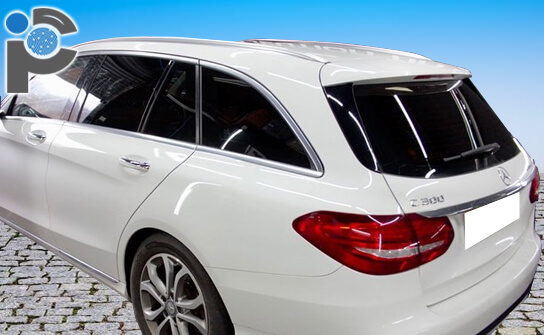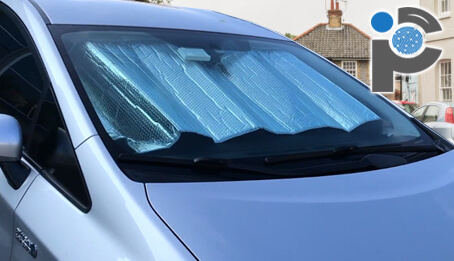Window Tint For Private Investigators
February 21, 2021 - Reading time: 8 minutes
Updated on: August 27, 2025
When it comes to conducting surveillance from inside a vehicle, the aim is usually to remain unnoticed by the subject or anyone else that happens to be in the area where surveillance is taking place. In many cases window tint can help private investigators to achieve that goal of remaining invisible.
What type of window tint do private investigators use?
5% limo tint is the most popular choice for private investigators. The “5%” figure refers to visible light transmission (VLT) - meaning only 5% of outside light makes it through the glass, with the other 95% blocked. This makes the window look very dark from the outside and, in most cases, stops anyone being able to see in. Some detectives even opt for a 3% or 1% tint, which works well in daylight but can be very difficult to see out of at night.
In countries where it’s allowed, many detectives apply window film to the front driver and passenger windows, as well as the windscreen, giving total privacy to their vehicle. For this type of setup, 5% on the front windows and 35% on the windscreen will achieve a good balance.
In the UK we are not allowed to apply dark film to the front driver and passenger windows or to the windscreen. Very light film (70-75%) can be applied to these windows, but it would be so light that no real privacy could be achieved. In the UK we are free to tint the rear windows of our vehicles to any level.

Photo: Though private investigators traditionally opt for very dark tint (such as 5% limo tint), some detectives prefer to use lighter tints and window coverings, believing that this makes them appear less suspicious.
Window film is always measured by how much light it lets through. So a 5% film means one twentieth of the light passes through, making it look very dark. A 20% tint lets through a fifth of the light and appears noticeably lighter from the outside.
How dark should window film be for privacy?
It’s difficult to see through window film which allows 20% of light (and under) to pass through. Films with a lower percentage of light transmission will provide better privacy, but also make it more difficult to see out of the vehicle in low light conditions.
If you are applying film to the front side windows of your vehicle (in jurisdictions where this is allowed) then 20% film provides a nice balance between privacy and being able to see out during low light conditions. If you are tinting every window in a vehicle, then the inside of the vehicle will be darker and thus harder to see into overall. In the UK where we can only tint the rear windows in our vehicles, a darker tint will need to be used in order to achieve that same level of privacy.
5% film provides better privacy than 15% or 20% film, however 5% is much more difficult to see out of at night. If there is more light inside your vehicle than outside (on an unlit road for example), then the effect of your film will be reversed, and you won’t be able to see outside.
What is ceramic window film?
Traditional window tint is made from layers of plastic with dye sandwiched in-between those layers. The technology behind window film is constantly being improved – for example, the film on some older vehicles tended to turn purple over time. This is no longer an issue with high quality modern films.
Ceramic window film is one of the latest innovations which is slowly becoming more prevalent in new vehicles. Whereas regular window film is made by trapping dye between layers of plastic, ceramic window film is made using microscopic particles of titanium nitride which are infused into the thin layers of film.
The benefit of this technology is that windows fitted with ceramic window film can reduce heat far more than with regular film. Switching from regular window film to ceramic, you will likely notice a big reduction of heat inside your vehicle on hot days. For private investigators that are spending a lot of time inside their vehicles conducting surveillance, upgrading to a ceramic window film can be a worthwhile investment for the reduction in heat alone.
Another benefit of ceramic film is that it can be easier to see out of at night, and more difficult for people to see in from outside the vehicle. Although ceramic film does cost slightly more than normal window tint, it is usually money well spent.
Installing window film in your vehicle
Unless you have some practice tinting windows, we would recommend hiring a professional to install film in your vehicle. This will ensure that you have a professional finish which is free from bubbles and imperfections. The cost of professional window tint installation in a standard 4 door hatchback starts at around £200, depending on the installer and quality of film being used. After installing window film, you will likely need to notify your insurer that your vehicle has been modified.
Disadvantages of tinted windows
Window film works best in the daytime when the amount of light outside your vehicle is greater than the amount of light inside. If a laptop screen is being used from inside a vehicle at night for example, then it will be easily visible to anyone outside. Taking photos/video from behind window tint can also become more difficult in low light conditions for this reason. If surveillance is being performed at night then the agent’s setup might be slightly different, as window tint cannot be relied on for privacy at night.
Sunshades and blackout curtains for surveillance vehicles
One solution to overcoming the issue of window tint during surveillance operations at night, is covering the windows using blackout curtains. A popular trick is to cut cardboard or foam pieces the same shape as your windows, the pieces can then be covered with black cloth and wedged over the windows when needed.
Curtains inside surveillance vehicles will need to be dark blackout curtains, which block all light from passing through. By covering windows in this way, the agent will be able to use their cameras, laptops, or any screens, and avoid being seen from the outside.
We would always suggest blocking windows with a black material, the reflective type sun shades shown below tend to stick out and are a lot more noticeable.

Photo: Reflective sunshades are effective at stopping people from seeing into your vehicle, but are not discreet and tend to stick out.
If sunshades or curtains are being used in the vehicle, then the agent will typically rely on cameras in order to see outside the vehicle and photograph the subject. If a vehicle is fitted with a dash cam, then often the investigator will hook-up an external monitor allowing them to see out. Dash cams which also feature cameras at the rear (or sides) of the vehicle are even better for this purpose and can allow the detective to see all around their vehicle while remaining totally hidden.
In some cases, temporary window film (usually static cling film) can be used to tint a window temporarily and then be removed and reused where needed. Temporary window film is especially useful if the agent is using a rented vehicle and cannot make any permanent modifications to the vehicle.
Related articles
You are reading the PrivateInvestigators-UK blog — home to the UK's leading detective agency. Learn more about us by visiting our homepage PrivateInvestigators-UK.com.